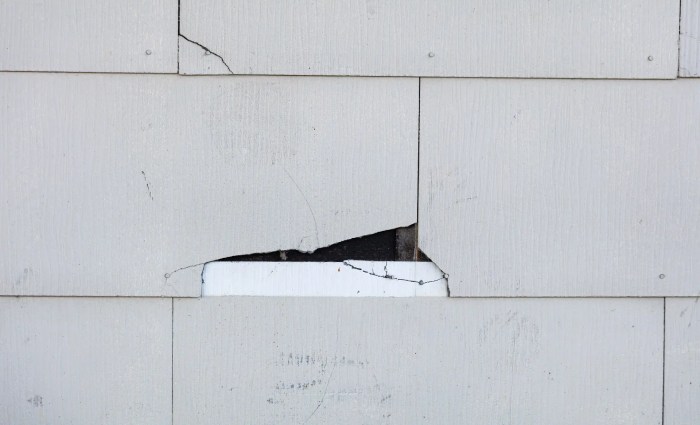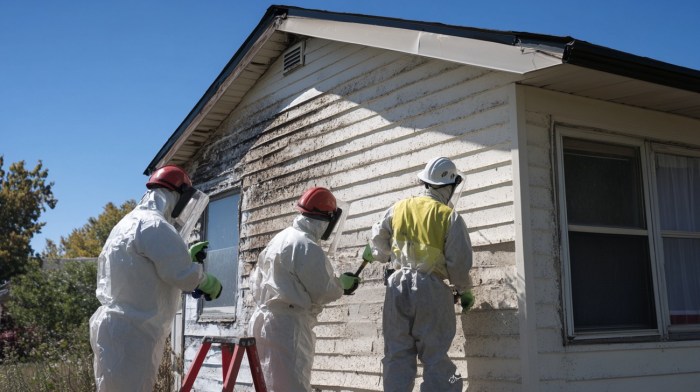Replacing Asbestos Siding: A Comprehensive Guide to Removal and Replacement
Embark on a journey into the world of asbestos siding replacement, where we uncover the risks, benefits, and steps involved in this crucial process.
As we delve deeper, you'll gain insights into the signs that indicate replacement, preparation needed, and options available post-removal.
Importance of Asbestos Siding Replacement
Asbestos siding, once a popular choice for its durability and fire resistance, poses serious health risks due to the asbestos fibers it releases when damaged or disturbed. These microscopic fibers can be easily inhaled, leading to serious respiratory diseases such as lung cancer, asbestosis, and mesothelioma.
Risks Associated with Asbestos Siding
- Exposure to asbestos fibers can lead to severe health issues, including lung cancer and mesothelioma.
- Asbestos siding deteriorates over time, releasing fibers into the air, especially during renovation or demolition.
- Children and pets are particularly vulnerable to asbestos exposure due to their closer proximity to the ground where fibers settle.
Benefits of Replacing Asbestos Siding
- Eliminating the health risks associated with asbestos exposure, ensuring a safer environment for occupants.
- Improving the overall aesthetic appeal of the property with modern siding options that are available in a variety of colors and styles.
- Increasing the property value by upgrading to more energy-efficient and durable siding materials.
Comparison with Modern Siding Options
Modern siding options such as vinyl, fiber cement, or engineered wood offer improved durability, low maintenance requirements, and better insulation properties compared to asbestos siding. They are also environmentally friendly and do not pose health risks like asbestos.
Signs That Replacement is Needed
When it comes to asbestos siding, there are several signs that indicate replacement may be necessary. It's important to keep an eye out for these signs to ensure the safety and integrity of your home.
Common Signs of Deteriorating Asbestos Siding:
- Cracking or chipping: Asbestos siding that is cracked or chipped can release harmful fibers into the air.
- Discoloration: Staining or discoloration on the siding can be a sign of water damage or deterioration.
- Warping: If the siding appears warped or distorted, it may no longer be providing proper protection.
- Loose or missing pieces: Any pieces of siding that are loose or missing should be addressed promptly.
Inspecting Asbestos Siding for Damage:
It's important to regularly inspect your asbestos siding for any signs of damage. Look for cracks, chips, discoloration, warping, or loose pieces. If you notice any of these issues, it's best to consult a professional to assess the condition of the siding.
Examples of When Replacement Becomes Necessary:
- Extensive damage: If a large portion of the siding is damaged or deteriorating, replacement may be the best option.
- Health concerns: If the asbestos siding is releasing fibers into the air, posing a health risk to you and your family, replacement is crucial.
- Aesthetic reasons: If the siding is significantly damaged and affecting the overall appearance of your home, replacement can improve the curb appeal and value of your property.
Preparation for Asbestos Siding Replacement
Before embarking on the task of replacing asbestos siding, it is crucial to prioritize safety measures to protect yourself and others from exposure to harmful asbestos fibers. Here are the steps to take before the replacement process:
Safety Measures
- Ensure to wear appropriate personal protective equipment (PPE) such as gloves, goggles, and a respirator to prevent inhalation of asbestos fibers.
- Seal off the work area to prevent asbestos dust from spreading to other parts of the property.
- Use proper asbestos removal techniques to minimize the release of fibers into the air.
- Dispose of asbestos-containing materials in accordance with local regulations to prevent environmental contamination.
Permits and Regulations
- Check with your local authorities to determine if a permit is required for asbestos siding removal.
- Follow all regulations and guidelines set forth by the Environmental Protection Agency (EPA) or other relevant agencies regarding asbestos removal.
- Hire a licensed asbestos removal contractor if needed to ensure compliance with safety standards and regulations.
Asbestos Siding Removal Process
Removing asbestos siding is a crucial step in ensuring the safety of your home and preventing health risks associated with asbestos exposure. The process involves specific steps, tools, and precautions to be taken to safely remove the siding without releasing harmful fibers into the air.
Steps Involved in Removing Asbestos Siding
- 1. Obtain necessary permits: Before starting the removal process, it is essential to check with local authorities for any required permits for asbestos removal.
- 2. Prepare the work area: Clear the area around the siding and create a containment zone to prevent asbestos fibers from spreading.
- 3. Wet the siding: Spraying the siding with water helps to keep the asbestos fibers from becoming airborne during removal.
- 4. Carefully remove the siding: Use hand tools to gently pry off the asbestos siding without breaking it into smaller pieces.
- 5. Dispose of the siding: Place the removed asbestos siding in sealed bags labeled for hazardous waste disposal.
- 6. Clean the work area: Thoroughly clean the work area and tools used in the removal process to prevent any residual asbestos contamination.
Tools and Equipment Needed for Safe Removal
- 1. Personal protective equipment (PPE): This includes a respirator, disposable coveralls, gloves, and safety goggles to protect against asbestos exposure.
- 2. Wetting agent: A spray bottle or hose with a misting nozzle to keep the siding wet during removal.
- 3. Hand tools: Such as pry bars, utility knives, and shovels for gently removing the siding.
- 4. Sealed bags: Specifically designed for asbestos disposal to contain and properly dispose of the removed siding.
Tips for Handling Asbestos-Containing Materials During Removal
- 1. Avoid sanding, cutting, or breaking the siding, as this can release asbestos fibers into the air.
- 2. Double bag asbestos-containing materials to prevent any potential leakage.
- 3. Minimize dust generation by wetting the siding before and during removal.
- 4. Dispose of asbestos waste according to local regulations and guidelines to ensure proper handling and disposal.
Replacement Options After Asbestos Siding Removal

After the removal of asbestos siding, it is crucial to explore various replacement options to ensure the safety and aesthetics of your home. Different siding materials offer varying costs, durability, and visual appeal, so it is essential to consider these factors when choosing a replacement.
Vinyl Siding
Vinyl siding is a popular choice for homeowners due to its affordability, low maintenance, and versatility. It comes in a wide range of colors and styles, offering an easy way to enhance the curb appeal of your home. While vinyl siding may not be as durable as other materials, it is a cost-effective option for those on a budget.
Fiber Cement Siding
Fiber cement siding is a durable and low-maintenance option that mimics the look of wood without the risk of rot or termite damage. It is resistant to fire, pests, and harsh weather conditions, making it a long-lasting investment for your home.
Although fiber cement siding may have a higher upfront cost, its durability and longevity make it a worthwhile choice for many homeowners.
Wood Siding
Wood siding provides a timeless and natural look to your home, adding warmth and character. While wood siding requires more maintenance than other materials, it can be easily painted or stained to match your desired aesthetic. With proper care, wood siding can last for decades, making it a classic choice for those who appreciate its traditional appeal.
Metal Siding
Metal siding, such as aluminum or steel, offers a sleek and modern appearance to your home. It is highly durable, resistant to fire, and requires minimal upkeep. Metal siding is available in various finishes, colors, and styles, providing a contemporary look that can enhance the overall design of your home.
While metal siding may have a higher initial cost, its longevity and low maintenance requirements make it a valuable investment in the long run.
Final Conclusion

In conclusion, asbestos siding replacement is not just about safety but also about enhancing the aesthetics and durability of your home. Take the leap towards a healthier environment today.
FAQ Corner
What are the risks associated with asbestos siding?
Asbestos siding poses health risks when damaged or disturbed, releasing harmful fibers into the air.
How can I inspect asbestos siding for damage?
Look for signs of cracking, chipping, or discoloration on the siding surface, indicating deterioration.
What safety measures are required before replacing asbestos siding?
Prior to replacement, ensure to wear protective gear, seal off the work area, and use proper disposal methods for asbestos-containing materials.
What factors should I consider when choosing a replacement siding?
Consider costs, durability, maintenance requirements, and aesthetic appeal when selecting a new siding material.




